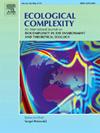Niche divergence mechanisms of closely related hybridising bird species. Modeling approach based on remote sensing data of forest habitats
IF 3.1
3区 环境科学与生态学
Q2 ECOLOGY
引用次数: 0
Abstract
Describing mechanisms that ensure stable co-occurrence of sympatric species is fundamental to understanding the complexity of ecological community dynamics. In this study, the Pied flycatcher and the Collared flycatcher were used as model species for the analysis of co-occurrence patterns of closely related hybridising species that inhabit overlapping forest habitats. I hypothesise that spatial niche partitioning between species emerges as a vital adaptive response to interspecific competition and manifests itself in significant shifts in habitat preferences in syntopic areas but not in the allotopic ones. The study leverages a comprehensive dataset that includes species density in 372 randomly selected 1 km² grid cells across the territory of Poland. The analysis of habitat preferences was performed with linear mixed-effect modeling, whereas a contrast analysis was used to investigate changes in habitat preferences resulting from the presence of a competitor. The findings indicate that both species modify their habitat preferences when transitioning between syntopic and allotopic sites. Remarkably, in regions without competitors, such shifts are significantly less pronounced, as demonstrated by the Pied flycatcher that prefers the same habitats both in allopatric regions and allotopic sites. When these results are compared with other studies on closely related hybridising and non-hybridising species, it turns out that what influences the degree and number of niches subjected to competition is the time that passes from species divergence. This study highlights the imperative need to incorporate co-occurrence parameters of closely related species into niche and species distribution models to enhance their ecological realism.
近缘杂交鸟类的生态位分化机制。基于森林栖息地遥感数据的建模方法
描述确保同域物种稳定共生的机制是了解生态群落动态复杂性的基础。在本研究中,我们以斑蝇鴷和领蝇鴷为模型物种,分析了栖息在重叠森林生境中的近缘杂交物种的共生模式。我的假设是,物种间的空间生态位分区是对种间竞争的重要适应性反应,表现为在同位区栖息地偏好的显著变化,而在异位区则没有。该研究利用了一个综合数据集,其中包括在波兰境内随机选取的 372 个 1 平方公里网格单元中的物种密度。栖息地偏好分析采用线性混合效应模型,而对比分析则用于研究竞争者的存在导致的栖息地偏好变化。研究结果表明,当在同域和异域之间转换时,这两个物种都会改变其栖息地偏好。值得注意的是,在没有竞争者的地区,这种偏好的改变并不明显,如皮德飞鸟在同域地区和异域地点都偏好相同的栖息地。将这些结果与其他关于密切相关的杂交和非杂交物种的研究结果进行比较后发现,影响竞争壁龛的程度和数量的因素是物种分化所经过的时间。这项研究强调了将近缘物种的共生参数纳入生态位和物种分布模型以提高其生态真实性的迫切需要。
本文章由计算机程序翻译,如有差异,请以英文原文为准。
求助全文
约1分钟内获得全文
求助全文
来源期刊

Ecological Complexity
环境科学-生态学
CiteScore
7.10
自引率
0.00%
发文量
24
审稿时长
3 months
期刊介绍:
Ecological Complexity is an international journal devoted to the publication of high quality, peer-reviewed articles on all aspects of biocomplexity in the environment, theoretical ecology, and special issues on topics of current interest. The scope of the journal is wide and interdisciplinary with an integrated and quantitative approach. The journal particularly encourages submission of papers that integrate natural and social processes at appropriately broad spatio-temporal scales.
Ecological Complexity will publish research into the following areas:
• All aspects of biocomplexity in the environment and theoretical ecology
• Ecosystems and biospheres as complex adaptive systems
• Self-organization of spatially extended ecosystems
• Emergent properties and structures of complex ecosystems
• Ecological pattern formation in space and time
• The role of biophysical constraints and evolutionary attractors on species assemblages
• Ecological scaling (scale invariance, scale covariance and across scale dynamics), allometry, and hierarchy theory
• Ecological topology and networks
• Studies towards an ecology of complex systems
• Complex systems approaches for the study of dynamic human-environment interactions
• Using knowledge of nonlinear phenomena to better guide policy development for adaptation strategies and mitigation to environmental change
• New tools and methods for studying ecological complexity
 求助内容:
求助内容: 应助结果提醒方式:
应助结果提醒方式:


